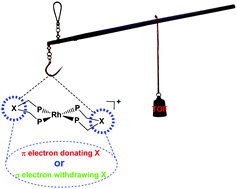Insight into the electronic effect of phosphine ligand on Rh catalyzed CO2 hydrogenation by investigating the reaction mechanism†
Abstract
Improving the catalytic efficiency of CO2 hydrogenation is a big challenge in catalysed CO2 recycling and H2 conservation. The detailed mechanism of [Rh(PCH2XRCH2P)2]+ (XR = CH2, N–CH3, CF2) catalyzed CO2 hydrogenation is studied to obtain insights into the electronic effect of the substituents at diphosphine ligand on the catalytic efficiency. The most favorable reaction mechanism is found to be composed of three steps: (1) oxidative addition of dihydrogen onto the Rh center of the catalyst; (2) the first hydride abstraction by base from the Rh dihydride complexes; (3) the second hydride transfer from the Rh hydride complexes to CO2. It was found that the transition state for the first hydride abstraction from the Rh dihydride complex is the TOF-determining transition state (TDTS) in the most favorable mechanism. The energetic span (δE) of the cycle is suggested related to the thermodynamic hydricity of the Rh dihydride complex. Model catalyst [Rh(PCH2CF2CH2P)2]+ with a strong σ electron withdrawing group on the diphosphine ligand provides higher hydricity in the Rh dihydride complex and lower activation energy when compared with the other two catalysts. Our study shows that it is the σ electron withdrawing ability rather than the electron donating ability that enhances the catalytic efficiency in catalyzed CO2 hydrogenation. This finding will benefit ligand design in transition metal catalysts and lead to more efficient methods for CO2 transformation.


 Please wait while we load your content...
Please wait while we load your content...